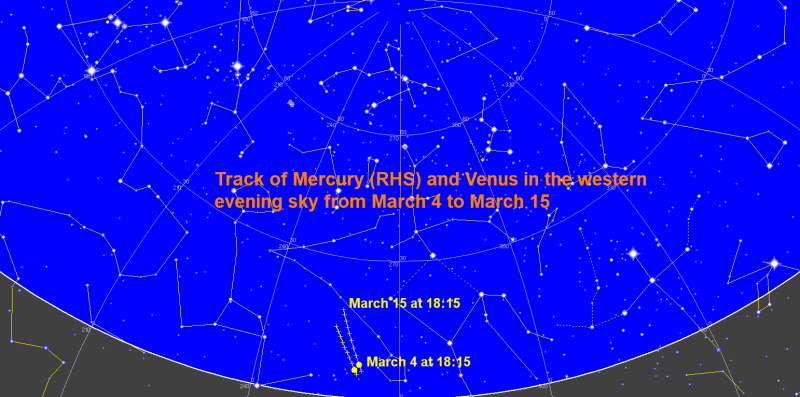2018 February 28
Mercury and Venus well displayed in the evening sky
Mercury has a reputation for being difficult to see and it is often reported that Copernicus failed to see it. I think the main problem is not that it is difficult to see, but rather that it is difficult to find. Once found, however, it can be an easy naked eye object. You just have to know when and where to look and this March, in the western evening sky, there is just such an opportunity.
Jupiter, with an orbital period of slightly under 12 Earth years and an average distance from the Sun of 5.2AU, is frequently visible in the sky for months on end (it is now rising before midnight and will dominate the southern sky for the next few months – albeit at a very low altitude). Mercury, however, with an orbital period of 88 days and an average distance from the Sun of only 0.39AU is too close to the Sun to be seen in a truly dark sky from the UK and needs to be caught when at its greatest angular distance from the Sun relative to the Earth – known as greatest elongation. With an orbital period of only 88 days it might be thought that these occasions would occur frequently enough to make Mercury a regular visitor to the evening or morning sky. The problem though is that not all elongations are created equal. In addition to being at greatest angular distance from the Sun it also needs to be at its greatest height above the horizon.
Mercury, along with the other planets, sticks closely to the path in the sky known as the ecliptic and the angle that the ecliptic makes with the horizon varies throughout the year. In spring the ecliptic in the evening sky rises steeply from the horizon meaning that Mercury, if it reaches greatest elongation around that time, will be at its greatest height above the horizon. Conversely in autumn the ecliptic in the morning sky is at its most vertical, so morning apparitions of Mercury are best seen then. An additional complication with Mercury is that its orbit around the Sun is highly elliptical and this affects how far above the horizon the planet appears to an observer.
This March, in addition to Mercury being well displayed, Venus also joins in the fun and the two planets get within 1 degree of each other on March 4. Unfortunately this will not be an easy observation as with the Sun setting at 17:46 UTC from London (17:53 from Edinburgh) the planetary pair will be only around 6 degrees above the western horizon at the end of civil twilight. A clear tree, building and murk free horizon will therefore be essential. Mercury will be shining at magnitude -1.2 and Venus considerably brighter at -3.9. If the sky is at all murky binoculars may help in the hunt, but never attempt this before the Sun has fully set. One glance at the Sun through any optical aid can lead to instant and permanent blindness.
The planets remain close together for the next few days, so if poor weather prevents observation on March 4 there will be other opportunities, although the angular distance between them will have increased. On March 5 the distance will be just under 1.5 degree and on March 10 just under 3.5 degree (see chart below). Mercury itself will be best seen on March 15, the date of greatest eastern elongation (18 degree), when at sunset (18:05 UTC from London) it will be 16 degrees above the western horizon. Mercury reaches perihelion (its closest point to the Sun) on March 10 so, for the reasons outlined above, this restricts its height above the horizon. On the day of Mercury’s greatest elongation Venus will be around 12 degrees up. After this, hopefully, splendid evening display Mercury moves ever closer to the Sun, reaching inferior conjunction – directly between the Sun and the Earth – on April 1. Before that though a young very slender Moon also gets in on the act (New Moon is on March 17) creating another interesting observing opportunity. And all at a reasonable time in the evening sky.
If you fail to see Mercury this time around there will be a further opportunity for northern hemisphere observers in August, but that will be in the morning sky.

[Thumbnail image on homepage taken from Stellarium 0.17.0]
| The British Astronomical Association supports amateur astronomers around the UK and the rest of the world. Find out more about the BAA or join us. |
